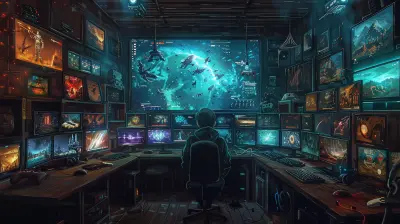Cloud Gaming: Is It Really the Next Big Thing?
8 October 2025
Let’s face it—gaming is changing. Back in the day, you had to wait in line at your favorite electronics store to get your hands on the latest console. Fast forward to now: streaming movies, music, and even whole software suites is second nature. So, it’s not surprising that games would eventually catch up. Enter cloud gaming.
But here’s the million-dollar question: Is cloud gaming really the next big thing, or is it just another overhyped tech buzzword?
Let’s talk about what cloud gaming is, what makes it so promising, the stuff holding it back, and whether or not it could genuinely reshape the future of gaming as we know it.
What Exactly Is Cloud Gaming?
Alright, before diving deep, let’s clear the fog. Cloud gaming, sometimes called game streaming or gaming-as-a-service, is essentially like Netflix—but for games.Instead of downloading a 100GB game to your console, your game runs on powerful remote servers. You send commands (move, jump, shoot) from your device, and the server handles the heavy lifting before streaming the game back to your screen.
In simpler terms? Your console is in the cloud, and your phone, laptop, tablet (heck, even your smart TV) is the remote control.
How Does It Work?
Imagine playing a high-end game like Cyberpunk 2077 on a 5-year-old phone. Sounds impossible, right? Well, cloud gaming says: “Hold my joystick.”Here’s the techy-but-simple version:
1. You pick a game on a cloud gaming platform (like NVIDIA GeForce NOW or Xbox Cloud Gaming).
2. That game is already installed and running on a remote server—basically a mega-powerful gaming PC in a data center.
3. Your input (keyboard, mouse, controller) gets sent over the internet.
4. The server processes it, renders the graphics, and then sends the video feed back to your device.
5. All of this happens in milliseconds. Wild, huh?
It’s like having a supercomputer in your pocket—minus the actual supercomputer.
A Brief History of Cloud Gaming
Believe it or not, cloud gaming isn’t that new. The first serious attempt came back in 2009 with a service called OnLive. It was ahead of its time but didn’t quite take off—lags, low-quality graphics, and poor internet infrastructure held it back.Fast forward to today, and the landscape has changed drastically. Fiber internet is more common, 5G is rolling out, and graphics can be streamed in 4K. Companies like Google (Stadia), Microsoft (Xbox Cloud Gaming), NVIDIA (GeForce NOW), and Sony (PlayStation Now) are all investing big time.
The Big Promises of Cloud Gaming
So why is everyone so hyped?1. No More Expensive Hardware
You don’t need to spend $500 on a console or $2000 on a gaming PC. That old laptop you’ve been using for college? It can suddenly run AAA titles—no upgrades needed.2. Play Anywhere, Anytime
On the bus, at grandma’s house, in a hotel—if you’ve got a decent internet connection, you’re good to go. No need to lug your rig around or worry about compatibility.3. Instant Access, No Downloads
Remember waiting hours for a game to download and install? Yeah, that’s gone. Cloud gaming lets you jump right in—zero wait time.4. Cross-Platform Heaven
Most cloud gaming platforms are device-agnostic. That means you can start a game on your phone and finish it on your PC. Seamless gaming has finally arrived.But What's the Catch?
Of course, it’s not all sunshine and rainbows. Like any tech, cloud gaming’s got its fair share of speed bumps.1. Internet Dependency
This one's the biggie. No internet? No game. Slow internet? Lag fest.Cloud gaming demands a solid connection—at least 15-25 Mbps for smooth performance. And if you’re trying to game during peak hours or on shaky Wi-Fi, prepare to rage quit.
2. Latency Issues
Ever tried to shoot an enemy in a game only to find out they already shot you first…because your input was delayed? That’s latency, and it’s a notorious pain in the cloud gaming world.Even just a 100ms delay can completely ruin the experience—especially in fast-paced competitive games.
3. Data Usage Bomb
Streaming games is mega data-heavy. A couple of hours can eat up several gigabytes. If you’re on a limited data plan or have a shaky connection, this could be a serious dealbreaker.4. Game Library Limitations
Not every cloud platform has every game. Some publishers are still hesitant, and rights can get messy. So, while you might be ready to dive into your favorite title, it might not even be available yet.Cloud Gaming Platforms Worth Your Time
So, who’s leading the charge in cloud gaming? Here’s a quick look:🔷 Xbox Cloud Gaming (xCloud)
Microsoft is flexing its Game Pass muscles here. If you’re a subscriber, you can stream a ton of Xbox games across devices. It’s integrated beautifully and already making waves.🔷 NVIDIA GeForce NOW
This one’s a favorite for PC gamers. It connects with Steam and Epic Games, so you can stream the games you already own. Plus, it supports ray tracing. Score.🔷 PlayStation Now (Now Part of PS Plus Premium)
Sony’s service has been around a while, offering a robust library of PS2, PS3, and PS4 games. It’s a bit more console-centric, but still solid.🔷 Amazon Luna
Still in its early stages, but Amazon is no small player. Luna is promising, with Twitch integration and a growing library.🔷 Google Stadia (RIP)
Once the poster child of cloud gaming, Google Stadia shut down in early 2023. Yep, even tech giants stumble. But it did bring useful lessons to the table.Who’s Cloud Gaming Perfect For?
Let’s be real: cloud gaming isn’t for everyone, at least not yet. But for some people, it’s a game-changer.- Casual gamers who don’t want to invest in pricey hardware.
- Travelers or people always on the go.
- Folks with decent but not cutting-edge devices.
- Anyone who values convenience over perfection.
If you’re someone who eats up cutting-edge graphics and ultra-low latency, cloud gaming might still fall short. But it’s catching up. Fast.
Could Cloud Gaming Replace Consoles?
Ah, the age-old question. Will cloud gaming kill consoles?Short answer? Not anytime soon.
Long answer? Probably not ever—but it might coexist.
Kind of like how streaming didn’t kill movie theaters, cloud gaming won’t necessarily destroy consoles. There’s room for both. Hardcore gamers love owning hardware, tweaking settings, and pushing boundaries. Cloud gaming is more about convenience and accessibility.
Think of it like this: You don’t use Uber because you hate driving—you use it because sometimes it’s just more convenient.
What Does the Future Hold?
Here’s where things get exciting.With the rise of 5G and fiber-optic networks, the biggest cloud gaming bottlenecks—latency and bandwidth—are slowly being solved.
Tech companies are heavily investing in AI-powered upscaling, lower latency, and more efficient data compression. In just a few years, the issues we talk about today could be completely irrelevant.
Plus, more developers are starting to build games with cloud gaming in mind. That means smoother performance, better visuals, and more intuitive controls tailored for streaming.
Final Thoughts: Cloud Gaming—Hype or Here to Stay?
So, is cloud gaming really the next big thing?Honestly? It could be.
Right now, it’s sort of like early streaming TV. Back when Netflix had a few shows and some okay-quality movies. But look at where we are now—you binge shows in 4K on your phone while waiting in line for coffee.
Cloud gaming feels like it's at that turning point.
It’s not perfect yet, but it’s showing so much promise. And as internet infrastructure catches up, we just might look back and wonder how we ever lived with long downloads, giant consoles, and endless updates.
If you’re a die-hard console gamer, don’t worry—you’re not being replaced. But for the rest of us? Cloud gaming could be the modern-day cheat code we’ve all been waiting for.
all images in this post were generated using AI tools
Category:
Gaming IndustryAuthor:

Whitman Adams
Discussion
rate this article
1 comments
Maxine McNeal
Cloud gaming promises convenience, but stability and latency issues could rain on its parade. Will it soar or plummet?
October 12, 2025 at 2:32 AM

Whitman Adams
Cloud gaming has potential, but its success hinges on overcoming stability and latency challenges. If these issues are addressed, it could soar; otherwise, it may struggle to gain traction.


